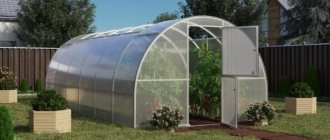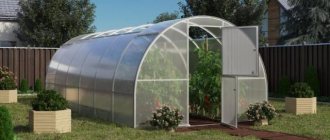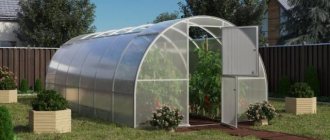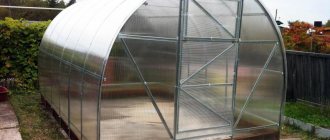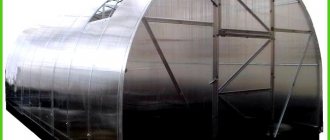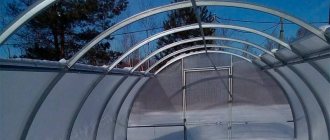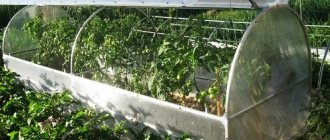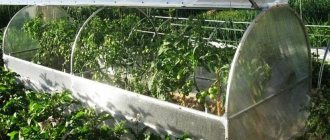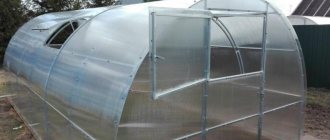Traditional greenhouses with closed sides, making it difficult to approach plants, and welded prefabricated arches, reducing resistance to loads, are being replaced by more reliable structures. Summer residents prefer durable products. The Tulip greenhouse with an opening roof and sides does not collapse under the weight of snow, allows you to conveniently approach the plants and get a rich harvest.
Features of the Tulip greenhouse
The new design of the Tulip greenhouse with a sliding roof and sides has a number of advantages along with the traditional ones:
- reinforced “anti-storm” guide arc system;
- simplified assembly using a four-bolt “crab” system;
- reliable frame made of all-welded arcs;
- Attached is a video instruction for assembling the Tulip greenhouse;
- sheets do not stick when condensation accumulates;
- the opening mechanism of the roof and sides is equipped with rubber seals;
- polycarbonate is mounted in guide arcs;
- no foundation required;
- the opening roof and sides are resistant to wind and snow loads;
- Warranty period up to 15 years.
Buy with this product:
Features and advantages:
- The new 2022 model has a fully opening roof and sides. Opens in 3 seconds!
- The tulip is made from a welded profile closed galvanized pipe 40*20 mm
- Width - 3.08 m, height - 2 m, length - 3.98; 5.98; 7.98; 9.98. meters.
- 2 doors at the ends. Each door has a window.
- The delivery includes all the kit necessary for assembly: bolts, screws, etc.
- No foundation required for installation.
- Service life - at least 10 years.
- Reliable design. Durable stainless frame.
- Natural pollination of plants by wind and insects. Natural soil moisture. In hot weather, plants grow in open ground.
- Small children can easily move the roof.
- No snow load on the greenhouse! The greenhouse will not break! Snow keeps the greenhouse soil from freezing.
Assembly and installation from 6500 rubles
Important! At the moment, analogs of the “Tulip” greenhouse with a frame made of 20 * 20 pipe are appearing on the market. Under wind loads in such greenhouses, sheets from the profiles can fly out
The frame of the “Tulip” greenhouse is made of a 40 * 20 pipe using a crab system to enhance the rigidity of the structure and to withstand strong wind loads. Beware of fakes!
We deliver Tulip greenhouses throughout Russia using our own forwarding service. Payment is made upon receipt.
For details about this greenhouse, please contact our managers by phone.
How to spot a fake
The “TULPAN” greenhouse is a development of AGS-Service LLC under the “Botanik” trademark. These greenhouses are produced only at the production of AGS-Service LLC located in Minsk. The TULIP greenhouse was developed and brought to perfection over the course of 2 years. The design and operational data of this greenhouse turned out to be so successful that many competing manufacturers are also trying to replicate the production of such a greenhouse. In an attempt to obtain additional profit and in order to reduce the cost of goods, they:
- They simplify the frame (use of pipes 20*20 and 25*25 instead of 40*20, fastening the cross members through bolts, not CRABs, etc., which significantly worsens the rigidity of the frame, and as a result leads to destruction),
- Guides made from recycled materials are used (which are subject to rapid destruction under the influence of sunlight and temperature changes),
- Changes are made to the design (simpler fittings, lack of additional hardware, etc.), which ultimately worsens both the quality in general and ease of use in particular.
The Tulip greenhouse is made of a 40*20 pipe using a crab system. If, when making a greenhouse with a sliding roof and sides, a pipe of a different cross-section is used, then there is a very high risk of destruction of the greenhouse under strong wind loads. In conventional greenhouses (where there is no opening of the roof and sides), polycarbonate plays a very important role in the resistance of the greenhouse to wind loads, because it is connected to the frame using self-tapping screws and increases the rigidity of the frame. That is why in conventional greenhouses you can use pipes 20*20, 25*25 or 20*20 with a double arc and at the same time make connections using bolts through holes in the arcs and cross bars.
In the Tulip greenhouse, polycarbonate does not have a rigid attachment to the frame, and therefore, if you install it on a frame made of a 20*20 pipe with a bolted connection, or even with a crab connection or using a double arc from a 20*20 pipe, then with strong wind exposure from the end or diagonal side, the geometry of the frame changes, which leads to polycarbonate falling out of the guides, and consequently to the destruction of the greenhouse.
As a result of repeated tests of the tulip greenhouse by the AGS-Service company, they came to the conclusion that only a 40*20 pipe in combination with the fastening of the crab system and cross bars also from a 40*20 pipe provides the necessary strength for the stability of the greenhouse against wind loads.
Authentication
Advantages and disadvantages
Advantages of the Tulip greenhouse with opening top:
- galvanized solid-bent arches increase the reliability of the structure;
- the opening roof mechanism eliminates snow loads;
- natural microclimate increases productivity;
- the opening roof and sides allow the greenhouse to be watered with rain, which enriches the earth with minerals;
- the opening mechanism of the sides promotes natural air exchange - plants receive the necessary dose of oxygen every day without drafts;
- opening sides allow you to conveniently approach each plant;
- the opening top will help fill the greenhouse with snow, this protects the soil from freezing and preserves its microflora;
- the guides are made of galvanized profile and equipped with a rubber seal at the points of contact with polycarbonate;
- opening sides and roof promote natural pollination of crops;
- The warranty period has been extended to 15 years.
Flaws:
- when installed without a foundation, severe distortion of the structure is possible;
- it is difficult to mount the opening element of the sides and roof to the arches;
- plastic parts lose elasticity in the cold, forming gaps between the frame and the guides of the opening mechanism;
- the manufacturer is located in Belarus, which complicates the supply of spare parts, since Russian distributors do not sell them;
- The crab system becomes loose during operation.
Advantages
A fairly large number of types of greenhouses are produced in Russia, each of which finds its own consumer.
A wide variety of models are offered:
- glass, polyethylene and polycarbonate;
- frames made of all-welded steel pipes and similar ones made of collapsible ones; the frame is made of plastic, wood or metal;
- equipped with windows (most models), opening (“Delta”) or sliding doors (“Tulip”, “Botanist”);
- with a removable ("Convertible"), sliding to the ends ("Matryoshka"), sliding ("Botanist") or opening roof ("Umnitsa").
As for the “Tulip” greenhouse, this is a product patented in the Russian Federation and the Republic of Belarus. This type belongs to the new products of 2022, that is, a completely “fresh” design. Like any other thing, the Tulip greenhouse has both advantages and disadvantages.
The undoubted advantages include several characteristics.
- No snow load. The roof of the greenhouse can be easily moved during cold periods, which will prevent it from being damaged by the weight.
- Since the snow will fall directly into the greenhouse, it will cover the soil and prevent it from freezing. This, in turn, will allow the preservation of favorable soil microflora, which will have a positive effect on the growth and development of crops in spring and summer.
- The use of this type of greenhouse helps create a natural microclimate for plants, which leads to increased productivity.
- Ensure proper ventilation thanks to sliding roof sashes.
- Possibility of natural watering. If you move the roof flaps apart, natural irrigation will occur during rain.
- Polycarbonate is considered one of the most durable and easy-to-use materials.
- Ease of use due to design features. With careful use, the service life will be more than 10 years.
This type of greenhouse also has its disadvantages.
- The rapid loss of appearance of polycarbonate and its wear and tear compared to glass greenhouses, as well as the expensive replacement of failed areas.
- Supporters of traditional greenhouse designs do not approve of replacing the vents with sliding sides and moving them to the doors.
- There is also an inconvenience that polycarbonate is not included in the greenhouse kit and must be ordered separately. True, some summer residents, on the contrary, are happy about this, since you can choose the density of polycarbonate to your liking. Manufacturers explain the need to separately purchase polycarbonate by the fact that there is currently no representative office of the company in Russia, and supplies from Belarus are expensive and unreliable in terms of the possibility of damage to the material.
- The main disadvantage of this type is its price, which varies from 25,000 rubles. up to 46,000 rubles, which can be quite a significant amount for most gardeners.
If we compare the “Tulip” with the “Delta” greenhouse, which at first glance has a similar type of device, we can highlight the main difference: in the first version the roof and sides move, and in the second they rise. Accordingly, “Delta” and other similar structures require additional space when its doors are open. This is not required for Tulip.
What can be grown in a Tulip greenhouse
One of the advantages of greenhouses with opening tops and sides is their versatility. Such greenhouses are perfect for growing fruits, vegetables and flowers. Often, a greenhouse is used to force tulips in early spring.
The structure is suitable for breeders. The innovative design allows you to freely approach plants and carry out the necessary experiments on them.
Design characteristics
New for 2022, the Tulip greenhouse with opening sides and a sliding roof is made from a closed galvanized pipe 40*20 mm. The ends of the structure are equipped with wide doors with built-in windows. A 1 m wide door connector allows you to bring a wheelbarrow into the greenhouse.
Important! The arcs are made of all-welded pipe. This increases the rigidity and stability of the structure.
Dimensions
The manufacturer produces a product with a width of 3 m, a height of 2.1 m, and a length of 4, 6, 8, 10 m. The length of the greenhouse can be increased at the customer’s request in increments of 2 m.
The opening side element allows free access to plants from all sides, so it can be installed closely between beds.
The size of the Tulip mini-greenhouse with opening sides is 2000*1100*1000 mm. At the request of the summer resident, the mini greenhouse can be equipped with a galvanized bed, in which case its height will increase by 200 mm. The modular system allows you to increase the length to 4, 6, 8, 10 m, in multiples of 2 m.
Materials
The frame of the greenhouse is made of galvanized pipes with a cross section of 40*20 mm. The innovative four-bolt crab fasteners are made from UV-resistant plastic or galvanized iron. If you have a choice, it is better to choose iron elements.
The roof is covered with Standard or reinforced Premium polycarbonate with a UV filter. The guides are made of profile and plastic with a UV filter and sealing rubber bands along the contour.
Equipment
The polycarbonate greenhouse set Tulip is equipped with:
- supports;
- guides that open the sides and roof;
- arcs;
- installation diagram;
- polycarbonate;
- bolts, hardware, self-tapping screws and screws;
- crab fasteners.
How much does a greenhouse with an opening roof cost?
One of the most budget-friendly options for a sliding greenhouse is “Marusya”. The frame is made of galvanized pipe 25x25 mm, its standard pitch is 1-0.5 m. The Marusya greenhouse can be installed either on a foundation or without a foundation. Please note that its length along the center line should be 2.07 / 4.11 / 6.15 / 8.19 / 10.23 meters, in accordance with the length of the greenhouse, and its width should be 2, 2.5 or 3 meters.
The Marusya greenhouse is well adapted to the Russian winterSource poradum.com.ua
A two-meter version of “Marusya” with an arc pitch of 70 cm will cost 12,000 rubles. A four-meter one will cost 16,900 rubles, and a ten-meter one will cost as much as 35,000. Moreover, many companies and trading platforms offer their assembly services. This option in the Moscow region costs approximately 6,000 - 10,000 rubles, depending on the length.
A 3x4 m "Tulip" greenhouse will cost approximately 13,500 rubles, and the same model 6 m long will cost 17,500 - 18,500 rubles. The same greenhouse with an opening top 10 m long costs about 46,000 rubles. The price is indicated taking into account the cost of polycarbonate.
“Botanik” costs even more. Such a 3x2 greenhouse with a glass coating and an aluminum frame will cost 60,000 rubles. If you increase the length by another 2 m, the price will be approximately 74,000 in Russian currency. The ten-meter “Botanist” costs about 136,000 rubles. Such high prices are associated with two features of this model: firstly, the manufacture of glass cladding is quite expensive and time-consuming, and, secondly, the frame itself has a rather complex design.
The “botanist” greenhouse is a high-quality, but expensive option. Source rusremontstroy.ru
Choosing a location for installation
The manufacturer guarantees that the greenhouse can be installed on any flat area. However, the structure is a reinforced structure, so assembly experts recommend building a foundation. It will be enough to build a log base from 100*100 mm timber.
The site on which the structure will be located must be in an open, sunny and windless place. A hard and level soil surface will protect the greenhouse from distortions.
The location of the greenhouse close to the house or barn will increase ease of use. Since there is always a need to carry buckets, boxes, and a fertilizer sprayer into it. But it is also necessary to take into account the proximity of the water supply point.
If the size of the plot allows you to squeeze the greenhouse only between the beds, you should leave space under the path for convenient passage.
Tips and tricks
Despite the fact that “Tulip” can be placed anywhere on the site, since the greenhouse does not require additional space when the doors are opened, there are a number of recommendations.
By following them, you can choose the best place to install the greenhouse.
- The area where the structure will stand must be sunny and windless. This will help the greenhouse warm up.
- It is not recommended to install a greenhouse near trees. Firstly, leaves may fall off, and if the tree bears fruit, then so will the fruit. Secondly, the thick crown will block the sun for greenhouse crops.
- The soil must be level and hard so that the structure does not warp.
- For the convenience of harvesting and transporting the crop, it is better to locate the greenhouse either next to the barn or to the house, so that carrying buckets or boxes with vegetables or fruits is not far away. Also, it should not be located far from the water supply system.
- It should be convenient to approach the greenhouse, so it is not recommended to place it close to the garden bed; you need to leave a path, at least a narrow one.
It is equally important to immediately decide what the greenhouse will be used for growing. If you plan to use the crop for personal use, then you should not invest too much in its purchase. If you have an idea in the future to build a business on gardening crops, then it is worth considering the possibility of purchasing a more spacious and impressive (including cost) structure.
Since “Tulip” is a greenhouse, polycarbonate for which is purchased separately, it is better not to save money and order the most dense and high-quality material. Both the strength of the future structure and its service life depend on this.
Assembling the Tulip greenhouse
To assemble the greenhouse, you will need the following set of tools:
- screwdriver with a cross and an 8 mm hexagon;
- 10 mm wrench;
- construction knife with a retractable blade;
- roulette;
- level.
It is recommended to install the Tulip greenhouse wearing cotton gloves with anti-slip rubber coating. In the selected area, it is necessary to level the ground and, if necessary, cover it with geotextile fabric.
Attention! Geotextiles are used on eroded and loose soils to strengthen the soil surface. It has drainage and reinforcing properties.
If the owner decides to build a foundation for the greenhouse, it is necessary to lay a beam measuring 10 * 10 m according to the dimensions of the greenhouse on a flat, prepared surface.
The set is equipped with lugs. If the foundation is not being constructed, it is necessary to install these supports around the perimeter. The lugs are leveled to avoid further distortion of the Tulip polycarbonate greenhouse.
The base is mounted level on the lugs or foundation. Using the “crab system” all elements of the structure are secured.
After installing the base, it is necessary to check the level of the future greenhouse diagonally. Arcs are attached to the base in 1 m increments.
The ends are sheathed with polycarbonate. The remaining material is cut end to end with a construction knife with a retractable blade.
The ends are installed on the base.
The arches installed on the base are securely fixed with guides using the Crab system. This element gives stability and rigidity to the structure.
The erected structure is checked by level.
Polycarbonate is cut out according to the dimensions of the sidewalls and roof elements.
Guides for the opening system are attached to the arches.
The covering material is tightened into the grooves for polycarbonate and a rubber seal is laid.
Window windows are installed.
Strengthen the connecting elements of the retractable polycarbonate structure with forks.
Check the operation of the installed greenhouse elements.
How to assemble a Tulip greenhouse on video:
How does it differ from analogues
The differences between the Tulip greenhouse and similar greenhouses are presented in the table:
| Regular greenhouse | Greenhouse Tulip |
| Collapsible arches are susceptible to destruction in winter and in very windy weather. The structure is unstable. | Solid bent arches increase the rigidity of the structure. Increases stability. |
| Products are made from profiles with a cross section of 20*20 mm. The thin pipe cannot withstand harsh weather conditions. | The production uses galvanized all-welded pipe with a cross-section of 20*40 mm. This increases the reliability of the structure under loads. |
| Cheap H-shaped guides made of plastic cannot cope with the load. In winter, when exposed to snow, polycarbonate swells and is squeezed out. | The innovative guide system is equipped with a rubber seal. This improves the ergonomic properties of the design. |
| Complex assembly. Lots of fasteners. | Welded parts greatly simplify the installation of the greenhouse. The greenhouse remains to be assembled like a construction set. |
| An open roof does not provide adequate ventilation. When the door and roof are open, a draft occurs, which reduces the immunity of plants. The sides are equipped with expensive windows. There is no opening mechanism. | The sliding system raises the sides and lowers the roof, which allows you to ventilate the greenhouse in 2 minutes in natural conditions without drafts. There is an opening mechanism. |
Advantages and disadvantages
It is worth highlighting the main advantages of the Tulip greenhouse.
- Convenient use of the design. The walls of the greenhouse move easily. Even a child has enough strength for this. It is not difficult to adjust the position of the polycarbonate elements depending on the weather. This will take just a few minutes.
- In winter, you won’t have to worry about snow breaking through the polycarbonate coating. The roof can be left “open”, resulting in zero load on the greenhouse.
- Due to the fact that snow fills the interior space of the building during the winter, the ground underneath will receive the necessary amount of moisture and minerals.
- The snow cover that forms during the winter inside the greenhouse (or a greenhouse built on the same principle as a large “Tulip”) will cover the soil like a blanket. The microflora inside the soil will not be affected, and plants will be able to obtain all the necessary substances from it in the summer.
- Practice shows that thanks to the “Tulip” design, it maintains the most favorable climate for plants, which allows achieving high yields.
- In the summer, when greenhouse crops no longer need active thermal protection, it is convenient to ventilate such a structure and clearly establish proper ventilation inside the “house for vegetables.”
- If summer has given the garden another rain, you can freely entrust watering to nature. The efforts of the owners of the future harvest come down to simply opening the roof over cucumbers, tomatoes and other greenhouse “tenants”.
- The arches, including those that make up the “skeleton” of the structure, are solid-bent, and not assembled from individual components. This increases the strength of all supports and allows for quick installation.
- The manufacturer has provided the possibility of installing an automatic ventilation system in the greenhouse, which regulates the microclimate in the building without human intervention. This is very convenient for summer residents, who do not have to worry that in their absence the weather will change and the plants will suffer.
- The design features of the “Tulip”, including the fact that the profile from which the structure of the building is assembled does not rust, allow it to be used for more than ten years, which is confirmed by an official guarantee.
It is also worth noting several shortcomings or controversial points.
- In comparison with glass, from which greenhouse buildings are still made today, cellular polycarbonate quickly loses the ability to transmit light normally under the influence of external factors. It becomes covered with dust, greenery from the cucumbers, tomatoes and others. As a result, it is more difficult for ultraviolet light, which is necessary for plant photosynthesis, to penetrate the structure. To prevent the appearance and functionality of polycarbonate from gradually fading away, it must be cleaned regularly.
- Manufacturers do not include polycarbonate itself in the delivery kit. It has to be purchased separately. Not every buyer is ready for such hassle.
- Unlike assembling a metal structure, when independently installing polycarbonate sheets on a finished frame, ordinary buyers, according to their own reviews, often encounter difficulties. To give the greenhouse a finished look, sometimes they have to resort to the services of specialists.
- The price of such a greenhouse can be intimidating. The cheapest model costs more than twenty thousand rubles.
Tips for use
The performance indicators of the Tulip greenhouse are characterized by increased reliability to weather conditions. However, any product loses its performance over time during use. In order for the structure to last longer, it is necessary to carry out seasonal inspection of the structure in the fall after harvesting and in the spring after wintering.
Warning! In the fall, it is necessary to turn off the water to the drip irrigation system so that the pipes do not burst due to frost. If water is supplied from a plastic barrel, it must be brought into a barn or other utility room.
When inspecting the structure, you should pay attention to the crab fasteners. Bolts and screws must securely and firmly fix the structure. If the connecting unit is loose and the elements become loose, the bolts must be tightened and, if necessary, replaced.
The guidance system of the retractable roof and sides of the Tulip greenhouse requires seasonal inspection. After winter weather, sudden temperature changes can cause the rubber seal to crack. If this happens, it must be replaced.
Selection criteria when purchasing
When choosing a “Tulip” greenhouse, first of all, you need to find a good manufacturer, then the main evaluation criteria will receive positive feedback.
When evaluating the proposed product, pay attention to:
- dimensions corresponding to the free space available on the territory;
- material for making the supports (these must be galvanized pipes measuring 40×20, no thinner);
- the presence of a sufficient number of jumpers between the main slats (the finished assembled frame should look coarse, composed of a large number of squares);
- material for the manufacture of guides for retractable mechanisms: it is desirable that they be made from all-welded metal pipes;
- The kit includes polycarbonate sheets. If they are, make sure that all material has the necessary insulating coating and is at least 4 mm thick.
An equally important selection criterion is the characteristics of the fastening elements. Like the main parts, they must be made of high-quality metal and have wide caps that protect against rain flowing through the mounting holes.
Photos of greenhouses
The photo shows a Tulip polycarbonate greenhouse from the inside:
You can see how the sides of the floors open and the roof goes down.
In winter, the roof opens and the greenhouse fills with snow.
The wide doors are equipped with a window.
The greenhouse used Premium reinforced polycarbonate with a UV filter.
Greenhouse ventilation option.
The innovative design allows you to equip a swimming pool in the greenhouse.
Portable mini-greenhouse Tulip with a bed made of galvanized iron, opening sides and roof.
Polycarbonate greenhouses with a sliding roof: user reviews
Today, the choice of greenhouses on the market is very wide - from ordinary greenhouses covered with plastic film to polycarbonate greenhouses with an automatic sliding roof. The latter have won the love and respect of many farmers due to their positive characteristics.
Summer residents give good reviews to such a model of greenhouses as the “Present”, released. The roof of the greenhouse opens, moving in arcs. In this way, individual parts of the roof can be opened completely or a small gap can be left only for ventilation of the plants in the greenhouse.
From May to September, plants in the greenhouse have the opportunity to receive natural light, heating and pollination, and during rains - natural watering.
Also, many users speak well of the greenhouses of the Kremlevskaya series - “Lux” and “President”. The frame consists of a wide-section stainless steel pipe. “President” can be installed on a wooden foundation - this will make the structure more stable.
